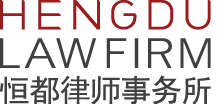The term “three-type shareholder” means corporate shareholders in the form of contractual type funds, asset management plans and trust plans. In IPO reviews, because some of such shareholders conceal such issues as multi-level nesting, high gearing and impenetrability in their backgrounds, they fail to satisfy the IPO requirement of “clarity of equity”.

JIANG FENGTAO
恒都律师事务所创始合伙人
Founding Partner
Hengdu Law Firm
“Three-type shareholders” often become a major obstacle to the realization of an IPO by New Third Board listed companies. Recently, the progressive clarification of the regulatory policies on “three-type shareholders”, together with the smooth approval by the China Securities Regulatory Commission (CSRC) of “three-type shareholder” enterprise Guangdong Wencan, give hope that the New Third Board “three-type shareholder” issue will be resolved.
On 12 January 2018, the CSRC specified the following clear requirements for a “three-type shareholder enterprise”:
First, based on the basic requirements of the Securities Law, the Company Law and the IPO Measures, the stability of the company and the clarity of the controlling shareholder and actual controller are basic conditions, and accordingly it is required that the controlling shareholder, actual controller or largest shareholder not be a “three-type shareholder”.
Second, given that the authorities are currently in the course of imposing compliance on the asset management business, they are, with a view to ensuring that “three-type shareholders” are established in accordance with the law and operating compliantly, requiring that such shareholders have already been subsumed under effective oversight of the financial regulator.
Third, with a view to guarding against the funnelling of benefits from the outset, preventing and controlling potential risks, and stringently overseeing highly geared structured products and multi-level nested investment entities, issuers to whom the above-mentioned circumstances apply are required to submit a rectification plan to make them compliant with the regulatory requirements, and to carry out a penetrative disclosure of the “three-type shareholders”. Additionally, the intermediary firms are required to verify whether the issuer and its stakeholders directly or indirectly hold rights or interests in the “three-type shareholders”.
Finally, to ensure compliance with current lockup period and shareholding reduction rules, “three-type shareholders” should make reasonable arrangements in respect of their periods of existence.
On 13 March 2018, Wencan became the first IPO applicant with “three-type shareholders” to successfully secure the CSRC approval. Wencan directly brought 10 “three-type shareholders” before the CSRC for review. The shares held by such shareholders account for 3.63% of the company’s total share capital. That Wencan smoothly secured the CSRC approval perhaps signifies that there is hope for the final resolution of New Third Board “three-type shareholders”.
The clarification of the review criteria and Wencan’s smooth securing of CSRC approval are a welcome fillip for IPO applications by “three-type shareholder” New Third Board listed enterprises. However, “three-type shareholders” remain a complex issue, and attention needs to be paid to the following issues at the time of a “three-type shareholder” enterprise IPO:
(1) May not contain gearing, classes or a nested structure. Pursuant to the CSRC’s review criteria, a “three-type shareholder” may not be a structured product or nest other products, and if such classes or nesting exist, that must be rectified. That structured products were not included, and that there was no nesting, are the key reasons Wencan was ultimately able to conduct a penetrative verification and smoothly secure approval.
Multiple nesting of products and layer upon layer of gearing will result in such issues as the inability to thoroughly penetrate the shareholder, inability to clarify the identity of the shareholders, etc. High gearing also affects the stability of a listed company. If there are classes, the obligations of the preferred and secondary shareholders will vary, and the preference funds could come from a bank’s wealth management fund pool, making the funnelling of benefits difficult to guard against, and making penetrative verification impossible.
(2) Penetrative verification is required. The review criteria expressly require a penetrative disclosure of “three-type shareholders”, penetrating down to the natural persons or state-owned entities. The objective of a penetrative verification is to ensure the clarity of equity. From publicly available information it can be seen that Wencan conducted a penetrative verification of the “three-type shareholders”, the penetrative verification percentage reaching 100%, and each of such shareholders signed a statement to the effect that they were not holding shares on the behalf of others.
However, in actual practice, a penetrative verification ultimately poses great difficulties. Investors in many “three-type shareholders” number in the several tens or even several hundreds, and many products are sold through third-party institutions, greatly adding to the workload in such verification. However, the regulatory requirements and CSRC approval precedents show that penetrative verifications remain mandatory. If the conduct of a penetrative verification is impossible, future clearing of the “three-type shareholders” will still be necessary. This requires enterprises to do everything in a compliant manner when first bringing in “three-type shareholders”, and to keep good file information on investors at the time of offering of the product so as to duly lay the groundwork for penetrative verification.

RUAN LANQUAN
恒都律师事务所助理律师
Paralegal
Hengdu Law Firm
(3) Reasonable arrangements for the period of existence need to be made. “Three-type shareholders” will have limits on their period of existence and products could mature while waiting in line for an IPO, or during the lockup period, affecting the stability of the company’s equity structure. To ensure compliance with current lockup period and shareholding reduction rules, it is necessary, in respect of “three-type shareholders”, to consider the issue of the life of a product and make reasonable arrangements for its period of existence so as to ensure that the life of the product can ultimately span the listing lockup period.
With respect to the extension of the life of a product, thought needs to be given to providing flexible arrangements in the contract, for example, specifying that the life of the product can be extended with the consent of two-thirds of the investors. Failure to make appropriate arrangements at the outset could result in the life of the product not spanning the lockup period, and ultimately requiring clearance.
Although regulatory policies have been clarified, and Wencan smoothly secured CSRC approval, nevertheless, given the characteristics of “three-type shareholders”, a high degree of vigilance is still required when dealing with relevant matters.
Jiang Fengtao is the founding partner and Ruan Lanquan is a paralegal in the capital market department of Hengdu Law Firm
北京市朝阳区建国门外大街1号
国贸大厦3期B座50层 邮编:100004
50/F, Block B, China World Trade Center Tower 3
No.1 Jian Guo Men Wai Avenue
Chaoyang District, Beijing 100004, China
电话 Tel: +86 10 5985 2999
传真 Fax: +86 10 5760 0599
电子邮箱 E-mail:
hengdulaw@hengdulaw.com






















